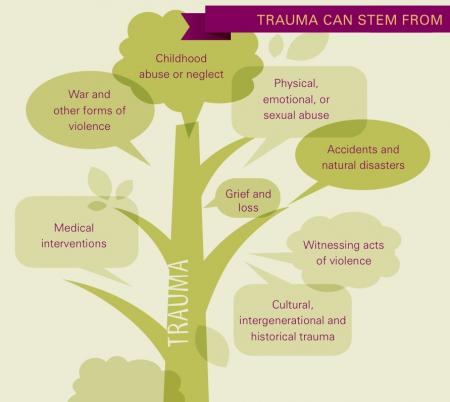Being abused can affect how we feel, think, and respond to other people and the world around us. It can also increase our risk for developing mental health and substance abuse conditions. Experiencing multiple forms of abuse and oppression over the course of our lives can further increase these risks. At the same time, stigma associated with substance abuse and mental illness allows abusers to use these issues to increase their control over their partners, undermine them in custody battles, and discredit them with friends, family, and the courts, underscoring the importance of ensuring that responses to survivors are both DV- and trauma-informed (Warshaw, Moroney, & Barnes, 2003; Briere, Woo, McRae, Foltz & Sitzman, 1997; Goodman, Dutton, & Harris, 1997; Warshaw et. al, 2009; Jacobson, 1989;Lipschitz et al, 1996; Goodman, Dutton, Harris, 1995; Friedman & Loue, 2007).
 A Trauma-Informed Approach
A Trauma-Informed Approach
Over the past three decades, as knowledge about trauma has increased, there has been a significant reassessment of the ways mental health symptoms are understood. We now have a better understanding of the role that abuse and violence play in the development of mental health and substance abuse conditions. Trauma-informed approaches reflect an understanding that “symptoms” may be survival strategies—adaptations to intolerable situations when real protection is unavailable and a person’s coping mechanisms are overwhelmed. Trauma-informed approaches focus on resilience and strengths as well as psychological harm. They also reflect an awareness of the impact of this work on providers and emphasize the importance of organizational support and provider self-care (Warshaw, Brashler & Gill, 2009; van der Kolk, Roth, Pelcovitz, Sunday, & Spinazzola, 2005; Saakvitne, Gamble, Pearlman, & Lev, 2000).
With the growing understanding that the majority of people seeking services in domestic violence, as well as mental health, substance abuse, and other service settings have experienced interpersonal trauma, an approach for integrating this awareness into practice has evolved. Using a trauma-informed approach has come to mean that everyone working in a service setting understands the impact of trauma in a similar way and shares certain values and goals, and that all the services and supports that are offered are designed to prevent retraumatization and to promote healing and recovery. For us, it also means thinking about people within the entire context of their lives and experiences; ensuring that our services are welcoming, inclusive and culturally attuned; and working together to address the underlying causes of oppression and abuse (Harris & Fallot, 2001; Warshaw, Brashler, & Gill, 2009; Kimerling, Alvarez, Pavao, Kaminski, & Baumrind, 2007; Golding, 2000).
Like DV victim advocacy, the trauma-informed movement within the mental health services field has historical roots in social and political advocacy. For over a hundred years, people diagnosed with mental illnesses (many of them women) fought to protect their rights and resisted what they saw as the "medicalization" of women’s issues (Levin, Blanch and Jennings, 1998). The mental health advocacy movement laid the groundwork for the adoption of trauma-informed approaches in the mental health system. Most recently, trauma-informed approaches are surfacing in hospitals and health clinics, classrooms and daycare settings, child welfare programs, homeless shelters, and job training programs.
Combining a trauma-informed approach with a DV victim advocacy perspective provides a more integrated framework for working with survivors. This framework can serve as a powerful tool for bridging perspectives and building collaboration between fields. See Thinking about Trauma in the Context of DV Advocacy: An Integrated Approach by the NCDVTMH (2013).









